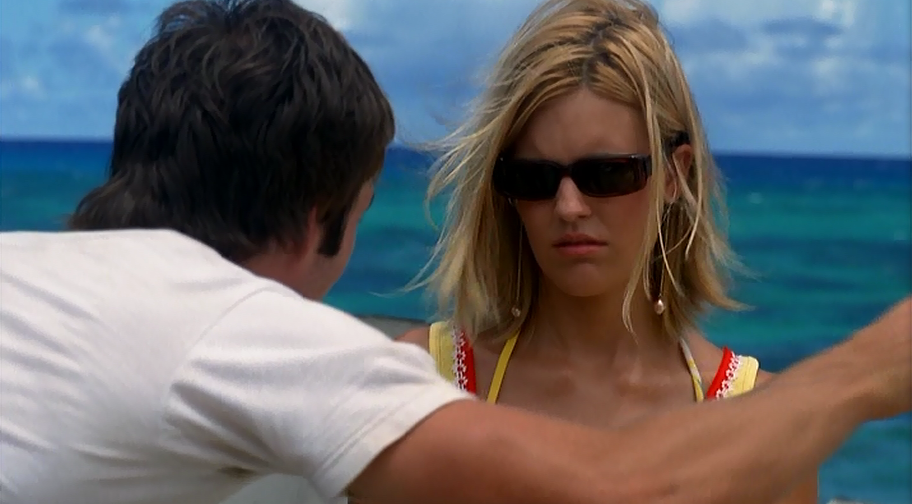What Did They Know And When Did They Know It?
An interesting document has turned up on the interweb: the 27-page pitch for Lost. It's May, 2004, and at this point, the pilot had been shot and just getting that massive amount of work done in a short time had almost destroyed J.J. Abrams and Damon Lindelof. But now they had to explain to ABC just how the premise--a group of survivors from a plane crash stuck on a mysterious island with some sort of monster--could play as a weekly show. (I believe this was the end of J.J.'s involvement in the show. Lindelof would take over and bring aboard Carlton Cuse to help run it.)
They admit there'll be trial and error, and the first season would spend a lot of time finding what the show is actually about. But here's their blueprint.
They say Lost will be many shows in one--a medical show, a cop show, a lawyer show, a character drama--and I think, especially with the flashbacks, they called it right. But there was still an overarching concept, the mystery of the island and the fates of the Losties, and it was the ultimate job of Lost--even if they didn't understand it yet (some might say never did)--to serve that.
They say the show will have elements of the fantastic, but grounded in reality, and sometimes it'd be fully realistic. I think they tried this with the first season--probably because they knew that's what ABC wanted--but moved further and further toward the fantastic as the show went along.
They promised, even with the overarching concepts and the character arcs, that each episode would be self-contained. I think they generally stuck to this, but the mythology was never so "easy to follow," as they promised. I suppose they put this in not only because they believed it, but also to reassure the suits--shows with huge arcs weren't so common on network TV a decade ago. Executives were frightened (especially in the days before widespread DVDs and Netflix and On Demand and so on) that if you couldn't drop in on any episode and understand what was going on, you'd simply lose fans as you went along without adding any.
They promise in the first season it'd be about the day-to-day struggle of the Lostaways, and they got this right. They predict the first season would take place over about forty days, and that's pretty close to how it worked.
As to the mysteries of the Island, they had some ideas, but they were fuzzy. They knew there'd be bunkers, and the castaways would discover them, also discovering that they go further and further back in history. There would also be at some time a corporate think tank/military contractor building on the Island and doing cutting edge experiments. This is essentially correct, though we're now talking about the Dharma Initiative, which was sort of hippie-dippy and sort of not, and which also was there in opposition to the "natives."
They also claim there's no "ultimate mystery" to explain, feeling this is a rabbit hole down which they don't wish to go. They were wrong about this. As the mythology got more complex, the mystery that would "explain" the Island was foremost on viewers' minds. They were forced to give an ultimate explanation, one which didn't satisfy many.
As for the Monster, they have vague ideas--it's man-made and has rules and is some sort of an elaborate security system. They hinted about this in the first couple seasons, but then decided on a very different explanation that's hard to square with their original ideas. They do know, however, that the Monster is related to others on the Island, opponents of the crash victims, who'd make themselves known in the first season.
There were 47 survivors but only 13 regular characters, so what to do with the rest? By the third or fourth episode, they were to start disappearing mysteriously, perhaps returning at a later date with half-remembered stories. This didn't quite happen. Instead, the rest of the characters were mostly in the background and used as cannon fodder. Meanwhile, new survivors would be introduced in the second season--though most of them would be killed as well.
For practical reasons, Abrams and Lindeloff recognized it would be good to have regular, standing sets to shoot a lot of scenes, rather than have everything done outside. So, they figured, in the first season the Losties would have to relocate, near where there's food and fresh water. This became a huge deal in the first season, but in the wider story simply didn't matter, and was essentially dropped as a plot point (or even as a set, I think).
How to service 13 regulars in an hourly show? They figure Jack and Kate will be front and center, while each hour, with its self-contained story, will be focused on three or four others. Interestingly, they don't seem to have hit upon the flashback concept yet, which was central to the show and made it different from anything else. They also recognize some characters will be more popular than others, so they can concentrate on them (and, though it's not explicitly stated, kill off the ones who aren't working).
They go into a paragraph for each character, much of which points toward the flashbacks we'd see. But some ideas never made it onto the show. Boone suffers from schizophrenia? Shannon falls for Sawyer? Hurley a repo man (and not a lottery winner)? And they don't seem to know Locke was paralyzed before the Island cured him, or Walt has magical powers.
They also come up with 33 potential storylines, most generally realistic, and most of which were ignored. A few were followed, and at least one would blossom into quite a lot--the Losties find a mysterious Hatch.
This is how TV pitches are, even after the pilot is shot. No matter how much you plan, the show, the actors, the viewers, often tell you what direction you need to go in. As far as the mythology, Lindelof and soon Cuse were so busy just creating hourlong stories that I'm not sure they had too much time to prepare for the long-range. They couldn't even be sure, after all, that Lost would last more than one season. But eventually, before the second season started, they had time to work out a lot more regarding the Island's mythology. And by season three, when they got ABC to agree to end the show at a certain point, they could even decide specifically how things would go. But this early, it's often catch as catch can.
PS Someone asked Damon Lindelof about the pitch, and he explains its main purpose was to show new president of ABC Steve McPherson that this show could work as a weekly series. They were especially interested in distancing it from J.J.'s previous show, Alias, which was serialized and was genre and had a big mystery behind it.
Once the show started and real writers had to come up with real episodes, they soon realized they had to do it their way and could ignore the pitch. I'm sure it helped that the show was a huge hit from the start (and was shot far away from Los Angeles or New York) so ABC would give them the freedom to find their way.




0 Comments:
Post a Comment
<< Home